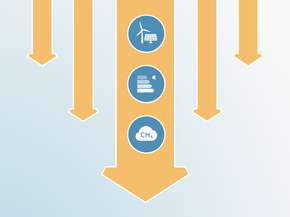Country summary
Overview
Ethiopia’s climate action illustrates the challenge of improving economic growth and energy access while enhancing climate mitigation action. The government announced an NDC implementation plan in July 2024, signalling a better commitment to reducing emissions, more integrated actions and a call for international support. Ethiopia is set to overachieve its unconditional and conditional NDC targets in 2030 under current policies, which will allow emissions to steadily increase and indicates that its targets could be more ambitious and also be strengthen. We continue to rate Ethiopia’s climate targets and action as “Almost sufficient”.
In 2024, Ethiopia became the first country in the world to ban the importation of internal combustion engine vehicles (ICEVs). To accelerate the transition to electric vehicles (EVs), the government removed VAT, surtax, and excise taxes on EV imports while reducing the import tax on partially assembled EVs. This policy supports Ethiopia’s target of achieving net-zero emissions by 2050, a goal first announced in 2015, while also enhancing the country’s energy security by reducing the amount of imported oil.
Ethiopia published a Long-Term Low Emissions Development Strategy (LT-LEDS) in July 2023 exploring multiple pathways to achieving net zero between 2035 and 2050. Based on the government estimates, the investments required to achieve net zero by 2050 range from USD 138 to USD 272 billion. The plan is aligned with Ethiopia's 10-year development plan and Updated National Determined Contribution (NDC).
Agriculture drives the Ethiopian economy, accounting for nearly 40% of GDP, employing 80% of the workforce, and contributing 90% of the country’s foreign currency through exports. It accounts for about 75% of emissions (excl. LULUCF). However, agriculture is one of the most vulnerable sectors and expected climate change induced hazards reduce an estimated 4% of the GDP. In 2024, Ethiopia published Climate Smart Agriculture Investment Plan (CSAIP) which outlines priority investment areas and strategies to enhance the agriculture sector resilience, sustainability, and productivity.
This CRGE strategy is the basis of the country’s climate action. It was launched in 2011, aiming to achieve middle-income country status by 2025. However, it faces several challenges in delivery due to the lack of representative data at national level. The government conducted an implementation review in 2020, which found no evidence of emission reductions since the CRGE strategy was introduced. The International Energy Agency (IEA) notes that the government has made progress on monitoring and evaluation processes as well as updating the CRGE strategy but does not specify when the update process began. As of early 2025, no updated version of the CRGE has been published.
In 2024, Ethiopia advanced its carbon finance efforts through a reforestation project aimed at restoring 12,000 hectares of native forest, with the goal of sequestering 7.26 million tonnes of CO₂ over 30 years. Ethiopia is planning to sell credits from forestry projects under Article 6. However, Ethiopia’s Article 6 strategy remains unclear, particularly regarding whether it includes safeguards to avoid missing its NDC target or failing to ratchet the ambition of its future NDC. Also, there are significant risks associated with forestry projects that the Article 6 rules might not be able to mitigate, such as inflated baselines and non-permanence.
Since the last update, there have been some positive development in Ethiopia’s climate action, such as:
- In 2024, Ethiopia published a 2030 Nationally Determined Contribution (NDC) implementation plan, which details sector-specific strategies designed to achieve the targets outlined in its NDCs.
- In 2024, Ethiopia has published Climate Smart Agriculture Investment Plan (CSAIP) which outlines priority investment areas and strategies
- Ethiopia has deals with renewable energy companies based out of the United Arab Emirates (UAE) to construct a 300MW wind farm and this initiative aligns with the National Energy Policy.
- In 2023, Ethiopia secured funding through the World Bank's BioCarbon Fund Initiative for Sustainable Forest Landscapes (ISFL). As part of its implementation, the program has established 51 forest tree nurseries in deforestation hotspots and trained over 22,800 forest users in sustainable practices.
- The government has integrated its Ten-Year Development Plan into its updated NDC and LT-LEDS.
Given Ethiopia’s socio-economic situation and its low historic contribution to global GHG emissions, Ethiopia’s policies and targets represent a fair contribution to limiting global warming with its own resources, to actually reduce emissions to a level consistent with 1.5ºC it needs to decarbonise its economy and will require international support to do so. Key measures needed for strengthening Ethiopia’s climate action include:
- Increasing the ambition of its conditional NDC target and quantifying the climate finance needed, including an implementation plan, to meet the set target. Being able to access sufficient climate finance is crucial for Ethiopia’s efforts to reduce its emissions, particularly in the AFOLU sector which contributes 80% of total country emissions. More initiatives similar to the EU's Multiannual Indicative Programme (MIP), which allocates EUR 260 million grants for climate-related initiatives in Ethiopia under the Green Deals would be necessary.
- Diversifying renewable energy sources to enhance energy security and resilience. Ethiopia's future electricity grid will rely heavily on the recently-built Grand Ethiopian Renaissance Dam (GERD). Given that hydropower is directly dependent on water sources, it is vulnerable to climate variability and regional water scarcity issues.
- Finding a lasting regional agreement between countries involved and affected by GERD hydropower project. Given the regional dispute over GERD, it is important to work towards enhancing the resilience of hydropower to climate changes and fostering cooperation over shared water resources.
- Adopting clean cooking practices to reduce reliance on biomass and mitigate potential health risks. This could involve investing in soft infrastructure development regarding public and environmental health, such as raising awareness about the health impacts of traditional cooking practices.
- Updating the CRGE, strengthening the human and fiscal capacity, and developing detailed measurement, reporting and verification (MRV) systems. Information related to the progress of CRGE is difficult to find and not centralised. Fragmented data management is barrier to CRGE implementation. It is essential that data is well documented, transparent and consistent across sectors and all levels of government. Since these challenges are often driven by limited human and fiscal capacity, strengthening institutional capacity and improving resource allocation must be prioritized.
- Improve its net-zero target architecture through the following good practices such as providing clear sectoral pathways and policies necessary, especially for waste and LULUCF sector, to achieve the net-zero target by 2050. This target also should be accompanied by legal safeguards or institutional framework, to ensure the continuity across political cycle.
Description of CAT ratings
The CAT rates each country’s targets and policies against (1) its fair share contribution to climate change mitigation considering a range of equity principles including responsibility, capability and equality, and (2) what is technically and economically feasible using modelled domestic pathways which in absence of a better method are based on global least-cost climate change mitigation.
Comparing a country’s fair share ranges and modelled domestic pathways provides insights into which governments should provide climate finance and which should receive it. Developed countries with large responsibility for historical emissions and high per-capita emissions, must not only implement ambitious climate action domestically but must also support climate action in developing countries with lower historical responsibility, capability, and lower per-capita emissions.
The Climate Action Tracker rates Ethiopia’s climate targets and policies as “Almost Sufficient”. This rating indicates that Ethiopia’s climate policies and commitments are not yet consistent with the Paris Agreement’s 1.5°C temperature limit but could be with moderate improvements.
Ethiopia is almost meeting its fair share contribution to climate change mitigation. Ethiopia’s unconditional NDC and policies and action are rated as “1.5°C compatible” when compared to its fair share. Ethiopia’s conditional NDC is rated as “Critically Insufficient” against modelled domestic pathways. As a country with lower responsibility, capability, and per-capita emissions, Ethiopia should receive international support to set an ambitious conditional NDC target beyond its national fair share and implement the policies necessary to achieve it.
Ethiopia can improve its rating by pledging a stronger conditional target compatible with limiting warming to 1.5°C.
The CAT rates Ethiopia’s policies and action as “1.5°C compatible” when compared to its fair share contribution to climate change mitigation. The “1.5°C compatible” rating indicates that Ethiopia’s climate policies and action are consistent with limiting warming to 1.5°C. Ethiopia’s climate policies and action do not require other countries to make comparably deeper reductions.
Ethiopia will overachieve both the unconditional and conditional NDC targets under current policies, indicating there is room for Ethiopia to increase its target ambition.
Ethiopia launched its NDC implementation plan in July 2024 signalling a stronger climate commitment with more integrated actions. Ethiopia became the first country to ban ICEV imports, while introducing tax incentives to accelerate electric vehicle adoption. In 2023, Ethiopia published its Long-Term Low Emissions Development Strategy (LT-LEDS), aligning it with the Ten-Year Development Plan.
The Climate Resilient Green Economy (CRGE) strategy, launched in 2011, remains the foundation of Ethiopia’s climate policy, though its implementation faces challenges due to limited representative data and weak coordination between sectors and governance levels.
The full policies and action analysis can be found here.
In its updated NDC, Ethiopia has committed to reduce emissions by 68.8% below a revised BAU (incl. LULUCF), conditional on international support. It will achieve a portion of these reductions unconditionally using its own resources.
The CAT rates Ethiopia’s conditional target as “Critically Insufficient ” when compared to modelled domestic pathways. The “Critically Insufficient” rating indicates that Ethiopia’s NDC conditional target in 2030 leads to rising, rather than falling, emissions and is not at all consistent with modelled domestic pathways limiting warming to 1.5°C. If all countries were to follow Ethiopia’s approach, warming would exceed 4°C.
Ethiopia should propose a conditional target that brings emissions down towards decarbonisation with external support. Its current conditional target is compatible with more than 4°C of warming and should thus be strengthened. Increased international support is needed to implement additional policies and meet a more ambitious conditional target.
The CAT rates Ethiopia’s unconditional NDC target as “1.5°C compatible”. The “1.5°C compatible” rating indicates that Ethiopia’s unconditional NDC target reflects the fair share for a least developed country consistent with limiting warming to 1.5°C. Ethiopia’s fair share target does not require other countries to make comparably deeper reductions or greater effort and is in the most stringent part of its fair share range.
Land use, land-use change and forestry are a significant source of Ethiopia’s emissions. Ethiopia intends to achieve the conditional and unconditional targets in its updated NDC primarily through reductions in land sector emissions (around 85% of total reductions).
In June 2023, Ethiopia submitted a Long-Term Low Emissions Development Strategy (LT-LEDS) for 2020-2050. The LT-LEDS outlines three pathways that could lead to net zero by 2050 or sooner, but Ethiopia has not yet formally committed to a specific pathway.
Ethiopia could further advance its net zero target’s transparency, target architecture, and scope by enshrining its net zero target into a law, providing information on whether its targets cover international aviation and shipping, and communicate transparent assumptions on the use of carbon dioxide removals.
The CAT evaluates Ethiopia’s net zero target as: “Average”.
The full net zero target analysis can be found here.
Further analysis
Latest publications
Stay informed
Subscribe to our newsletter




